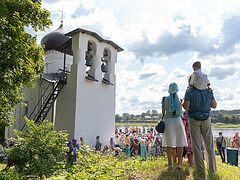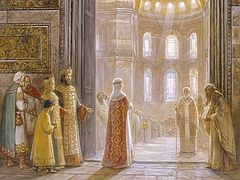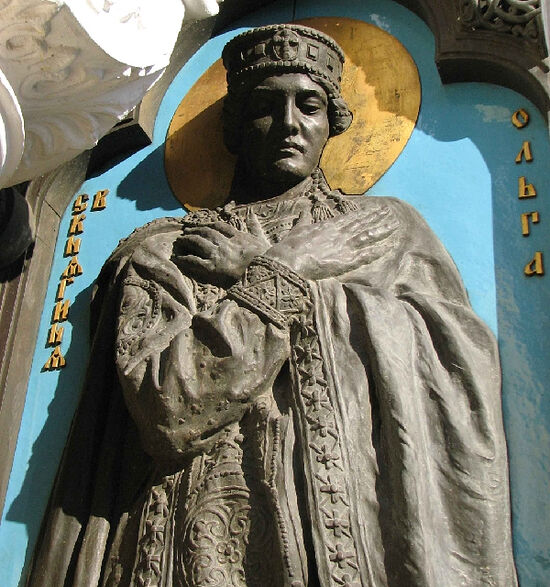 Bas-relief on the doors of the main portal of the St. Vladimir Cathedral in Kiev
Bas-relief on the doors of the main portal of the St. Vladimir Cathedral in Kiev
One hundred and forty years after Princess Olga’s death, an ancient Russian chronicler wrote of the first Russian saint:
“She was a harbinger of the Christian land, like the morning star before the sun, like the dawn before sunrise. She shone like the moon at night, so brightly did she shine among the pagans, like a pearl in the mud.”
For centuries, she has been called the “root of Orthodoxy,” and in her youth, she was known as “marvelous among maidens.” She embraced Christianity around 957—the first among Russian rulers to do so—three decades before the Baptism of Rus’ by her grandson Prince Vladimir, upon whom Olga had a profound spiritual influence.
Grand Princess Olga and Grand Prince Vladimir the Baptizer stand together in the history of Rus’ not only as relatives, but also as two holy people, honored by the Church as Equals-to-the-Apostles for their labors in Christianizing the Russian lands.
On July 11/24, 969, St. Olga, Equal-to-the-Apostles, reposed in the Lord. She is a figure who unified the lands of Ancient Rus’. The commemoration day of her grandson, St. Vladimir, Equal-to-the-Apostles, falls five days later, on July 28. Today, the entire Russian land—Great, Little, and White [the historical names for Russia, Ukraine, and Belorus)—celebrates the Baptism of Rus’ on this day.
***
In 2003, when the city of Pskov, celebrated its 1100th anniversary, two monuments to this great Pskov native were erected.
One of them, by Zurab Tsereteli, depicts Olga as a warrior with a sword and shield. It was installed by the residents of Pskov in a new district of the city.
However, our attention is drawn more to the monument by Vyacheslav Klykov, placed in ancient Pskov, near the St. Olga Bridge, close to the St. Olga Embankment in the Children’s Park, right next to a sacred place for the people of Pskov—the Kremlin, or as it was called in olden times, the Krom.
Walking along the alley of the Children’s Park towards the Krom, one can see how the Grand Princess’s hand reaches not only over her young grandson, but also to the Trinity Cathedral, which has been called the “House of the Holy Trinity” since ancient times.
This symbolism is significant, as St. Olga established the special veneration of the Holy Trinity in Rus’. The story of her vision near the banks of the Velikaya River has been passed down through the centuries. The Princess saw “three most radiant rays” descending from the sky from the east. Addressing her companions, who witnessed the vision, Olga prophetically said: “Let it be known to you that by God’s will there will be a church here in the name of the Most Holy and Life-Giving Trinity, and there will be a great and glorious city, abundant in everything.” There she erected a cross. The church later built in the name of the Holy Trinity became the main cathedral of Pskov.
The mystical paths of spiritual succession transmitted this veneration through four centuries. to St. Sergius of Radonezh.
The bronze statue of Princess Olga by Klykov covers her legacy, including (and primarily) the spiritual continuation in her grandson Vladimir. The composition reflects their inseparability and succession, as these figures, mutually complementing each other, embody the maternal and paternal principles of Russian spiritual history.
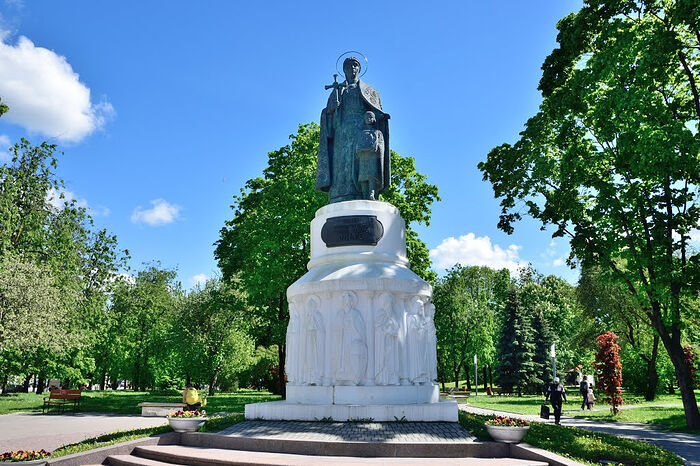 Monument to Holy Princess Olga in Pskov. Sculptor Vyacheslav Klykov. Photo taken on June 8, 2014
Monument to Holy Princess Olga in Pskov. Sculptor Vyacheslav Klykov. Photo taken on June 8, 2014
The white pedestal of the monument to the founder of Christianity in Rus’ is surrounded by beautiful bas-reliefs of saints, executed in the style of ancient Russian carvings. Klykov used a technique often employed by the famous sculptor Mikhail Mikeshin—the main character of the monument is supported—like spiritual pillars standing through the ages—by twelve figures of saints, in this case, predominantly from Pskov, which is both logical and spiritually significant. These saints, like Olga’s pan-Russian spiritual roots, include Pskov princes Dovmont-Timothy and Vsevolod-Gabriel, Prince Alexander Nevsky, Venerable Nikander, Martha of Pskov, Vassa of the Pskov-Caves, St. Tikhon (Patriarch of Moscow and All Russia), St. Cornelius of the Pskov-Caves (who, as we recall, was beheaded by Tsar Ivan the Terrible), Metropolitan Benjamin, Grand Duchess Elizabeth Feodorovna, and Blessed Nicholas Salos.
Today and always, it is important to remember that the small city of Pskov has historically been the northwestern military outpost of Russia, renowned for both its military strength and its great host of heavenly protectors. By Presidential Decree No. 1387 of December 5, 2009, Pskov was awarded the honorary title of “City of Military Glory.”
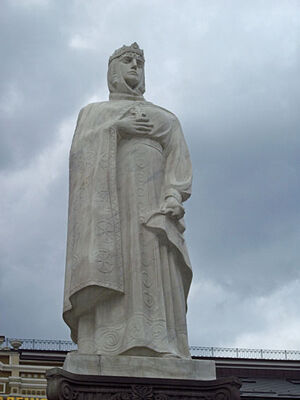 Monument to Holy Princess Olga in Kiev. Sculptor: I. Kavaleridze Let us also recall Mikeshin’s Olga on the famous “Millennium of Russia” monument in Veliky Novgorod. The image of the “Grand Princess of Russia” also came into artistic focus during the celebration of the 900th anniversary of the Baptism of Rus’. During those years, Princess Olga appeared in the works of V.M. Vasnetsov and many other painters. N.A. Bruni painted a severe, indomitable in her faith, and beautiful princess for the mosaic of the Church of the Savior on Blood in St. Petersburg.
Monument to Holy Princess Olga in Kiev. Sculptor: I. Kavaleridze Let us also recall Mikeshin’s Olga on the famous “Millennium of Russia” monument in Veliky Novgorod. The image of the “Grand Princess of Russia” also came into artistic focus during the celebration of the 900th anniversary of the Baptism of Rus’. During those years, Princess Olga appeared in the works of V.M. Vasnetsov and many other painters. N.A. Bruni painted a severe, indomitable in her faith, and beautiful princess for the mosaic of the Church of the Savior on Blood in St. Petersburg.
The dramatic fate of the monument to Princess Olga in Kiev, created by the famous Kiev sculptor Ivan Kavaleridze in the early twentieth century, is well known. The monument was lost and only recently restored. Today, the monument to the precursor of the great Baptism of Rus’ stands in Kiev near the St. Michael’s Golden-Domed Monastery, alongside figures of the Apostle Andrew the First-Called and Sts. Cyril and Methodius, teachers of the Slavs. I.P. Kavaleridze won the competition for the best design of the monument to Princess Olga in Kiev together with sculptor Snitkin and architect Rykov in 1910. At the insistence of Metropolitan Flavian, there were changes made to the original—the princess was deprived of her sword, given a pectoral cross, and her arm, bent at the elbow, was placed on her chest.
Erected in St. Michael’s Square with the inscription, “She was the first from Rus’ to enter the Kingdom of Heaven, for the sons of Rus’ praise her as their leader. A gift from His Majesty the Emperor to the city of Kiev. The year of Our Lord, 1911,” the monument fell victim to the godless authorities. In 1919, the stone princess was toppled from the pedestal, shattered, and buried. The side figures were initially covered with boards, and four years later, they were removed altogether.
Many years later, the composition returned to its original place. All parts of the sculpture, except for the head, were found. Using sketches and photos, the entire sculpture was recreated, but this time from white marble instead of concrete. The monument was restored in 1996 by sculptors V. Sivko and N. Bilyk.
As in the Pskov region and the city of Pskov itself, which abounds in toponyms and structures associated with Princess Olga, the image of the holy princess appears repeatedly in ancient Kiev-Rus’: in monuments, bas-reliefs, and murals. Considering that Princess Olga was the forerunner of Christianity in Rus, this abundance can hardly be considered excessive.
***
The Joachim Chronicle clarifies that Olga (Helga, Volga, which in Varangian meant “holy”) belonged to the Izborsk princes—one of the ancient Russian princely dynasties.
Later, Olga ruled Kiev during the campaigns of her husband Igor Rurikovich and as a regent (from 945 to 960) after his death. She brutally avenged his death on the Drevlians, raised her son Sviatoslav, and governed her territories.
Her life describes Olga’s efforts as follows:
“And Princess Olga governed the regions of the Russian land under her control not as a woman, but like a strong and wise man, firmly holding power and courageously defending against enemies. She was feared by her enemies and loved by her people as a merciful and pious ruler, a righteous judge who harmed no one, punished with mercy, and rewarded the good. She instilled fear in the wicked, repaying everyone according to their deeds. Throughout her reign she demonstrated foresight and wisdom. Olga, merciful by nature, was generous to the poor, the weak, and the needy; she quickly responded to just requests and promptly fulfilled them... Along with all this, Olga led a temperate and chaste life, refusing to remarry and remaining a pure widow, preserving the princely power for her son until he came of age. When he became an adult, she handed over all administrative affairs and distanced herself from public life, dedicating herself to charity.”
The author of the “Stepennaya Kniga” (Book of Degrees) writes:
“Her podvig consisted in finding the true God. Not knowing the law of Christianity, she lived a pure and chaste life and desired to become a Christian of her own free will, finding the path to the knowledge of God with the eyes of her heart and following it without hesitation.”
And St. Nestor the Chronicler poetically tells us:
“Blessed Olga sought wisdom from a young age, which is the best thing in this world, and found the pearl of great price—Christ.”
Having entrusted Kiev to her grown son, Olga set off with a large fleet to Constantinople. Historian N.M. Karamzin called her the first Russian pilgrim. The ancient Russian chroniclers described this as Olga’s “journey,” combining religious pilgrimage, diplomatic mission, and demonstration of Rus’ military might.
Patriarch Theophylactos of Constantinople (933–956) performed the sacrament of Baptism over her, and her godfather was Emperor Constantine Porphyrogenitus (912–959), who provided a detailed description of the ceremonies during Olga’s stay in Constantinople in his work “On the Ceremonies of the Byzantine Court.”
At one reception, a golden plate adorned with precious stones was presented to the princess. Olga donated it to the treasury of the Hagia Sophia, where it was seen and described by the Russian diplomat Dobrynya Yadreykovich, later Archbishop Anthony of Novgorod, in the early thirteenth century:
“There is a large golden service plate of St. Olga of Rus’, which she took as a tribute on her journey to Constantinople. On Olga’s plate is a precious stone, and on that stone is an inscribed image of Christ.”
The Patriarch blessed the newly baptized princess with a cross carved from a single piece of the Life-Giving Cross of the Lord. The cross bore the inscription: “The Russian land is renewed by the Holy Cross, which Olga, the faithful princess, accepted” (after the conquest of Kiev by the Lithuanians, Olga’s cross was stolen from the St. Sophia Cathedral and taken by Catholics to Lublin. Its fate after this is unknown). At her baptism, the princess was given the name of Holy Equal-to-the-Apostles Helen (from ancient the Greek “torch,” “light”.—S.M.), who labored greatly in spreading Christianity in the vast Roman Empire, and who found the Life-Giving Cross on which the Lord was crucified.
When she returned to Kiev, Olga brought with her icons, liturgical books, and the determination to convert the Russian people to Christianity. She built a church in honor of St. Nicholas over the grave of Askold, the first Christian prince of Kiev, and preached the faith in her native North.
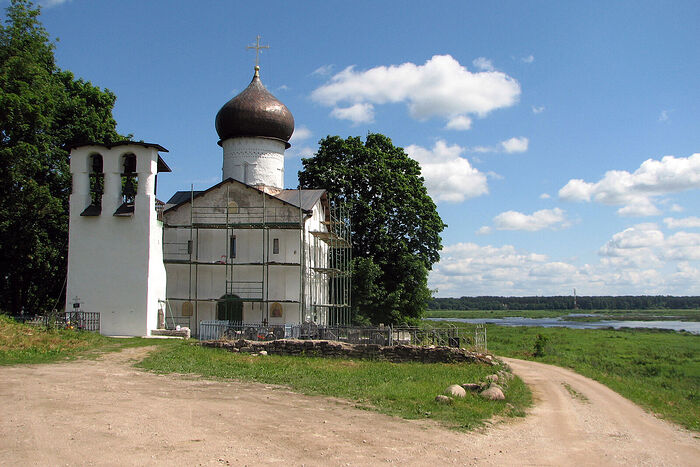 In Princess Olga’s native land. The cemetery church in Vybuty, near Pskov. Church of St. Elias. Photo taken on June 9, 2014
In Princess Olga’s native land. The cemetery church in Vybuty, near Pskov. Church of St. Elias. Photo taken on June 9, 2014
Princess Olga’s maternal efforts had dramatic, and even tragic results: Her successful warrior son Sviatoslav remained a pagan, and under his orders, Olga’s nephew Gleb was killed.
Upon Olga’s death, “her son and grandchildren and all the people wept for her with great lamentation.” Princess Olga was canonized as a saint with the lofty title, “Equal-to-the-Apostles” at the Council of 1547, which confirmed her widespread veneration in Rus’, established even before the Mongol invasion.
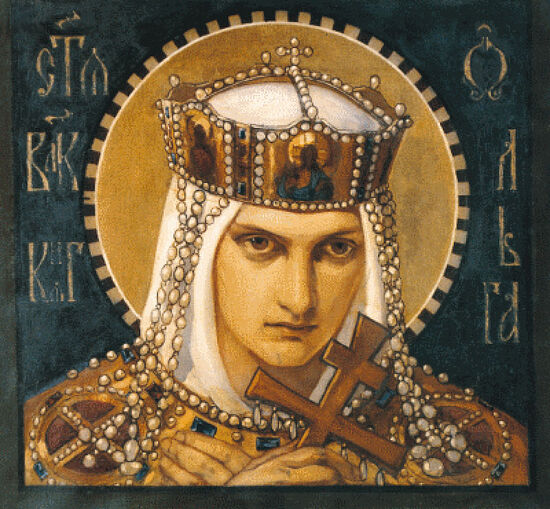 Holy Equal-to-the-Apostles Princess Olga. Work by N. Bruni.
Holy Equal-to-the-Apostles Princess Olga. Work by N. Bruni.
The relics of the “founder” of the faith in the Russian land were preserved incorrupt. During the reign of Prince Vladimir, they were transferred to the Holy Dormition Church of the Tithes and placed in a reliquary. According to tradition, there was a window in the church wall above the tomb of St. Olga, and those who came with faith could see the relics through the window. Some even saw them radiating light, and many of the sick received healing. For those who came with little faith, the window did not open, and they could only see the tomb.
We must remember that on the eve of her death, until her very last breath, Olga prayed fervently, especially for the enlightenment of the Russian land after her death. She repeatedly predicted that God would enlighten the people of the Russian land, and many of them would become great saints. Much of what our pan-Russian founder of the faith prophesied has come to pass.
Holy Equal-to-the-Apostles Princess Olga, pray to God for us!


